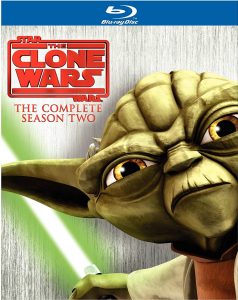When Boba Fett appeared 30 years ago in “The Empire Strikes Back” wearing Mandalorian armor (so named in the “Empire” novelization) that was associated with the Clone Wars (a vague concept mentioned by Obi-Wan in the first movie), the logical assumption was that he was a Mandalorian mercenary who fought in the Clone Wars.
In 1983, Marvel produced a comic book where this was indeed Fett’s backstory. In 1996, the book “Tales of the Bounty Hunters” revealed him to be a “journeyman protector” in his past. But until the prequel movies came out, Fett’s backstory was only covered in the broad, contradictory strokes of those two pieces of fiction. (His future, after he blasts out of the Sarlacc and continues bounty hunting, was chronicled more thoroughly.)
The assumption among fans was that George Lucas would clear it all up in the prequels. In fact, I was always under the impression that the absence of a definitive origin tale for Boba Fett was purposeful. I assumed Lucas had told his Lucasfilm licensing team (which oversees all the fiction) that story was off-limits because he had something planned.
Well, in 2002’s “Episode II: Attack of the Clones,” Lucas told the origin story of Fett, but in doing so he rendered the previous teaser origins as apocryphal. Now Fett was revealed to be the young son of bounty hunter Jango Fett during the Clone Wars. I imagine my response reflected that of many fans: I immediately accepted this origin story as canon, yet I was kind of angry that Lucas contradicted previous stories he had signed off on. (Interestingly, the Lucasfilm licensing team not only monitors which stories are “allowed” by George, but it also keeps track of continuity, making sure that new stories don’t contradict old stories. But the biggest continuity re-writes come from Lucas himself.)
Anyway, I wasn’t crazy about Fett-as-a-kid. My impression is that the general fan response was mixed. It went like this: Sure, he’s a whiny kid, but he’s not as annoying as Anakin in “Episode I” or Jar Jar Binks or C-3PO-on-a-battle-droid’s-body. In the pick-your-battles game of “Star Wars” fandom, most fans gave Lucas a pass on this Boba Fett thing.
It always bothered me a bit, though, especially being a fan of “Tales of the Bounty Hunters.”
This brings me to last week’s episode of “Star Wars: The Clone Wars” (8 p.m. Central Fridays on Cartoon Network, with a one-hour season finale this Friday).
In this episode, Boba Fett infiltrates a group of young clones-in-training and attempts to assassinate Mace Windu! Windu, as you may recall, beheaded Jango Fett in the arena battle at Geonosis, and little Boba was later shown holding his father’s helmet (presumably, and disturbingly, with Jango’s head still inside). That scene now plays like a teaser for this episode. Did Lucas have this episode in mind when he wrote “Attack of the Clones?” If so, wow.
In a way, Windu’s dispatching of Jango is similar to Boba’s “death” in “Return of the Jedi” where Han accidentally activates Boba’s rocket-pack, sending him careening into the Sarlacc. In both cases, a significant villain is casually killed by a hero who has other things on his mind.
From a story standpoint, it might’ve been cooler to have Anakin be the one who killed Jango, because then you’d wonder what Boba was thinking when he worked for Vader in “The Empire Strikes Back.”
But at any rate, Mace killed Jango, so now Boba wants revenge. The episode doesn’t get the voice quite right (Boba should have a thick New Zealand accent, but instead he’s voiced by an American kid), but everything else is brilliant, and it redeems this new-origin-of-Boba-Fett thing for me.
The clone kids each take a crack at shooting targets, and everyone misses — except Fett, who nails all three targets in quick succession. Even when Boba’s not sneaking away from his group and acting suspicious — that is, even when he’s just another kid in the group, being quiet and obedient — he has that glaring expression that we remember from “Episode II.” It’s an animated show, and yet my eye was always drawn to a specific character. Sure, that happens with charismatic actors, but in a cartoon? That’s quite an achievement.
And the ending of the episode is awesome as it re-introduces Aurra Sing, who had always been vaguely tied up in the Boba Fett mythos and now is revealed to be his mentor. Did Lucas have this in mind when he introduced Sing as a pod-race spectator in “Episode I?” If so, wow again.
As a bonus bit of intrigue, Sing’s sidekick is a Trandoshan who might be Bossk. If it is, that probably contradicts stories previously written about Bossk, but I’m keeping an open mind.
Sing was the first bounty hunter in the films chronologically, and Boba Fett was among the first bounty hunters in the films as they were made. Greedo was actually the first, but he was killed in the same scene that introduced him, so let’s say that Fett was the first bounty hunter to capture fans’ imaginations about what a bounty hunter did.
And now, as if it’s an “Empire” 30th anniversary gift to fans, we’re finally getting that story in full. It doesn’t make the famous Marvel No. 68 or the cult-favorite “Boba Fett’s Tale” any less great. And remember, whether they were part of the official canon or not, those stories were just teasers from Fett’s past. “Clone Wars” is giving us Boba Fett’s detailed story, courtesy of Lucas (not directly, perhaps, but more directly than the previous yarns).
It’s Boba Fett in a way I never imagined him before. But I’m kind of OK with that, and that’s another great accomplishment by “The Clone Wars.”


